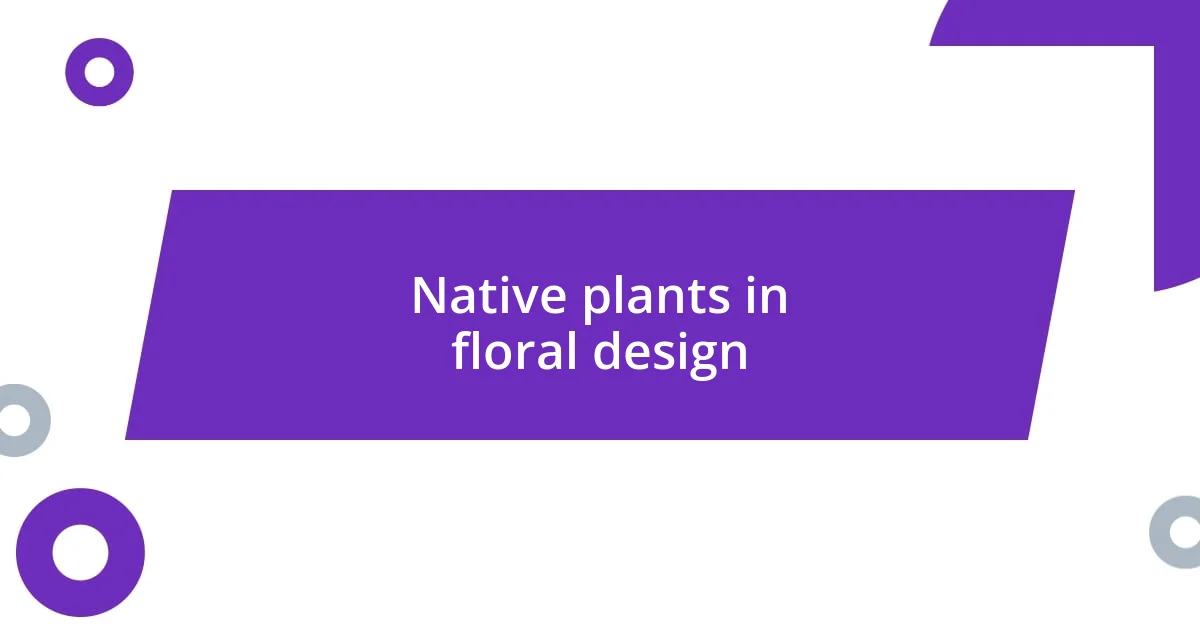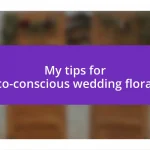Key takeaways:
- Floristry connects deeply with biodiversity; using local, native plants not only enhances beauty but also supports ecosystems.
- Sustainable practices, such as composting and using seasonal blooms, are crucial for promoting a healthier floral industry and environment.
- Educating clients about the importance of sustainability fosters a greater appreciation for local ecosystems and encourages mindful consumerism.

Understanding floristry and biodiversity
Floristry is not just about creating beautiful arrangements; it’s deeply connected to biodiversity and the health of our ecosystems. I often think about my own experiences wandering through lush gardens, noticing how diverse plant life coexists and thrives together. Isn’t it fascinating to consider how each flower contributes to a broader ecological tapestry?
I remember my first encounter with a wildflower meadow. The colors and fragrances were intoxicating, but what struck me most was the buzzing of bees and the fluttering of butterflies. This vibrant scene underscored a crucial point: every species has a role in maintaining balance. As florists, we can support biodiversity by choosing local, native plants for our arrangements – which not only provide beauty but also create vital habitats.
Furthermore, when we celebrate diverse flora in our work, we’re embracing the story of our environment. Each flower tells a tale of resilience and adaptation. I often ask myself: how can we, as florists, help people appreciate these connections? By educating our clients about sustainable choices and the importance of protecting these fragile ecosystems, we can inspire more mindful consumerism in the floral industry.

Importance of biodiversity in floristry
Biodiversity in floristry is essential for multiple reasons. For one, diverse plant species can significantly enhance resilience against pests and diseases. I recall a time when I used a mixed bouquet of local wildflowers, and it not only held up longer but also attracted beneficial insects. This experience taught me that by incorporating a broader variety of plants, we can support not just beauty in arrangements but ecological balance in our surroundings.
Moreover, utilizing a range of flowers allows florists to create truly unique compositions. Each bloom adds its own story, with varied textures, colors, and fragrances. I often find inspiration in unexpected places, like a forgotten corner of my garden where a rare flower suddenly bursts forth. It reminds me that every plant has a potential role in our creations. The more I explore biodiversity, the more I see how it enriches my artistry and the messages I convey through every arrangement.
Creating awareness about biodiversity can help foster appreciation for our natural world. When I share the stories behind the flowers in my arrangements, clients often become more conscious consumers. I’ve seen firsthand how people respond when they learn about the local ecosystems from which these blooms originate. It’s an opportunity to connect hearts and minds, and I believe it’s a crucial aspect of being a responsible florist in today’s world.
| Aspect | Importance |
|---|---|
| Resilience | Diverse plant species enhance resilience against pests and diseases. |
| Creativity | Varied blooms inspire unique and artistic arrangements. |
| Awareness | Sharing stories promotes appreciation for local ecosystems. |

Sustainable practices in floristry
Sustainable practices in floristry are essential for nurturing both our craft and the planet. I remember visiting a floristry workshop where the instructor passionately emphasized the importance of sourcing flowers locally. It was eye-opening to learn how choosing blooms that thrive in our region not only reduces carbon footprints from transportation but also supports local farmers. This simple switch can make a profound impact, creating a more sustainable floral industry.
Here are some sustainable practices florists can adopt:
- Using Seasonal Blooms: Ensures that flowers are at their peak, reducing waste.
- Choosing Organic or Pesticide-Free Flowers: Contributes to healthier ecosystems by avoiding harmful chemicals.
- Utilizing Eco-Friendly Packaging: Moving away from plastic to biodegradable options helps reduce waste.
- Composting Floral Waste: Turns spent flowers into nutrient-rich soil, closing the loop in the floral lifecycle.
- Educating Clients on Sustainability: Fostering a greater appreciation for eco-friendly choices through shared knowledge.
Every step taken towards sustainability feels rewarding. I vividly recall when I began composting my floral scraps. It’s incredibly satisfying to visualize those vibrant petals transforming into nutrient-dense soil. It reminded me that sustainability isn’t just a practice; it’s a mindset that enriches both my creations and the environment. Each arrangement becomes not just a decoration, but a part of a larger ecological story.

Native plants in floral design
Incorporating native plants into floral design is a choice I deeply value. I remember my first attempt at a bouquet using only local flora. The colors were vibrant, and the scent was a delightful surprise—each bloom felt like it carried its own story. This experience highlighted how native plants not only thrive in their environment but also provide a sense of place to my arrangements.
Using native species also brings a unique rhythm to floral design. I often find myself captivated by the subtle differences in texture and shape that these plants offer compared to common imported varieties. It’s like discovering the chapters of a book that you didn’t know existed. Each flower adds depth and conveys a narrative that resonates with both the land and the local community.
I often ask myself, what better way to celebrate our surroundings than to feature the beauty that already grows here? Embracing native plants invites clients to appreciate their local ecosystem. It fosters a connection that extends beyond the vase, reminding us of our role in protecting the natural world. When I share arrangements crafted from familiar blooms, it transcends aesthetics; it becomes a shared homage to the landscape itself.

Enhancing biodiversity through floral arrangements
I can’t help but feel a sense of joy when I incorporate wildflowers into my arrangements. Recently, I gathered a handful of local daisies and purple coneflowers from a nearby field. What struck me the most was how these humble blooms drew in bees and butterflies, bringing a living element to my work. Isn’t it fascinating how a simple bouquet can create a safe haven for these creatures? Each piece I craft becomes a tiny sanctuary, contributing to the vibrancy of our local ecosystem.
Floral arrangements can be a powerful medium for enhancing biodiversity, especially when we prioritize pollinator-friendly plants. I recall arranging a centerpiece from sunflowers and zinnias, which not only provided a burst of color but also served as a magnet for bees throughout the summer. It’s invigorating to think about how my choice of flowers directly influences the habitat around us. Each arrangement is more than just an aesthetic choice; it’s a commitment to nurturing life in all its forms.
Taking it a step further, I’ve started to share knowledge about these plants with my clients—pointing out which flowers attract local pollinators and explaining their importance. It’s heartening to see their curiosity spark during these conversations. I often wonder, how can we strive for beauty in our arrangements without considering the impact on the world around us? By weaving this understanding into my designs, I’m not only creating art; I’m inspiring a movement towards greater ecological awareness in our community.

Educating clients about sustainability
Educating clients about sustainability is not just a side note for me; it’s a central part of my floral practice. I vividly recall a moment with a client who was amazed to learn that flowers sourced locally could last longer and look fresher due to reduced travel time. The excitement on their face when I explained how this choice supports local farmers and reduces carbon footprints was unforgettable. I felt a bit like a teacher, revealing the interconnectedness of our choices and their impact on the environment.
I often include a brief chat about sustainable practices when I deliver arrangements. There was one particular delivery where I mentioned the importance of compostable packaging, and the client’s eyes lit up with understanding. “So, it’s not just about the flowers!” they exclaimed. That sentiment really stuck with me. It’s vital for clients to recognize that every detail, from how flowers are grown to how they’re wrapped, contributes to sustainability. I find it rewarding to instill that sense of responsibility and pride in their purchases.
Moreover, I love prompting discussions around seasonal flowers. I remember a conversation with a bride who was initially set on a peony-heavy bouquet, even though it was out of season. Once I introduced her to the beauty of late summer blooms, her perspective shifted. “I never thought about what’s in season!” she said, genuinely excited. Moments like these remind me that education can transform preferences into practices, helping clients develop a more sustainable mindset. Engaging clients in this way doesn’t just enhance their experience; it cultivates a shared responsibility toward our environment.














